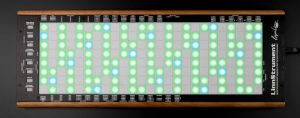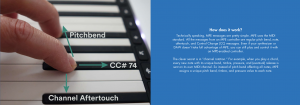MPE - MIDI Polyphonic Expression
How to create MPE Sounds?
Description courtesy of Roger Linn
MPE stands for "MIDI Polyphonic Expression" and is a new MIDI standard created by Roger Linn Design, ROLI, Apple, Moog, Haken Audio, Bitwig and others for communicating over MIDI between MPE controllers (like Sensel Morph, Roli Seaboard, LinnStrument, Continuum, SoundPlane or Eigenharp) and MPE sound generators (like these).
The principal reason for MPE is to get around a limitation of MIDI: Pitch Bend and Control Change messages must apply to all notes on the channel. This prevents polyphonic pitch bends and polyphonic Y-axis control (which uses Control Change messages) over a single MIDI channel. MPE solves this problem by sending each note's messages over a separate MIDI channel, rotating through a defined block of channels. Here's a brief summary of MPE:
Each note's messages are sent over a unique MIDI channel, rotating through a defined contiguous block of channels called "Member" channels (called Per-Note channels on LinnStrument). These per-note messages are limited to Note On, Note Off, Channel Pressure (for finger pressure), Pitch Bend (for X-axis movement) and CC74 (for Y-axis movement).
For messages that apply to all notes, like Program Change, CC7/volume, CC64/Sustain, etc., these are sent over a separate "Master Channel" (called "Main Channel" on LinnStrument), which is either channel 1 or 16. If 1, the Member channels are 2 through as high as 16. If 16, the Member channels are 15 through as low as 1. A split MPE keyboard could, for example, send the left split over Master channel 1 and Member (per-note) channels 2-8; and send the right split send over Master channel 16 with Member (per-note) channels 9-15. You can choose how many Member channels are allocated to each split.
Unlike the pitch bend wheels on standard MIDI keyboards, MPE controllers require that you set the Pitch Bend Range. For example, setting LinnStrument's Bend Range to 12 semitones means that sliding your finger 12 note pads to the right will send a Pitch Bend value equal to that of moving a traditional bend wheel fully forward. To insure that pitch slides are in tune, the Bend Ranges of both the MPE controller and MPE synth must be set equal. The default Pitch Bend Range for MPE controllers and synths is 48 semitones.
In LinnStrument, MPE is called "Channel Per Note" mode. The reason for the different terms is that LinnStrument existed well before MPE and these terms are printed on LinnStrument's panel.
What about Multi-Timbral synths?
Multi-timbral synths are similar to MPE synths. A multi-timbral synth is capable of producing two or more simultaneously sounds (timbres), with each timbre receiving from a different MIDI channel. They are intended to, for example, produce both a bass and chord sound when connected to a split keyboard, or to produce multiple monophonic parts from a sequencer, each with a different sound. However, a multi-timbre synth can be used as an MPE synth by setting all timbres to the same sound, and setting the receiving channels for the timbres to the same range of Member channels sent from the MPE controller. Omnisphere and Kontakt are examples of mulit-timbral synths that can be used in this way for MPE play.
The disadvantages of multi-timbral synths are:
- if you wish to make a change to the sound (like adjusting filter frequency), you must make the exact same change to all timbres redundantly, and.
- there is no Master channel, so your MPE controller must send all such common messages (like sustain pedal, CC7/volume or Program Change) redundantly over all Member channels. This is possible on LinnStrument by turning off the Main channel. (Press the selected Main channel button to deselect it.).
What about one-channel synths?
The main advantage of MPE controllers and synths is polyphonic expressive control, permitting three dimensions of independent touch control for each of simultaneous touches. That's why the "P" in "MPE" means "polyphonic". But what about one-channel synths that permit the same three dimensions of touch control for monophonic solo lines?
To be accurate, an MPE synth must be polyphonic because "monophonic MIDI polyphonic expression" is an oxymoron. But any synth can deliver MPE's touch expression for monophonic lines merely by creating sounds that use the same control assignments as MPE: Finger pressure for Channel Pressure, x-axis finger movement for Pitch Bend, and y-axis finger movement for CC74. Audio Modeling's monophonic synths for winds and bowed strings are excellent examples of expressive one-channel synths because the sounds are already set up to use the same MPE MIDI assignments and therefore work well with all MPE controllers. And LinnStrument has a one-channel compatibility mode specifically for this use.
MPE Sounds
What are MPE Sounds? MPE sounds are sound patches that are optimized for performance on MPE controllers.
These sounds have two main differences from sounds optimized for standard MIDI keyboards:
- They respond not only to velocity, but also to three dimensions of continuous touch:
- Left/Right movement (X axis): typically used for continuous pitch control, sent using MIDI Pitch Bend messages.
- Forward/backward movement (Y axis): typically used for continuous control of timbre, sent using MIDI Control Change 74 messages.
- Pressure (Z axis): typically used for continuous loudness control, sent using MIDI Channel Pressure messages.
- They permit each simultaneous touch to have independent three-dimensional control, because each note is sent over a separate MIDI channel.
The purpose of this page is permit you to upload and share your MPE sounds with other players of MPE controllers.
Each submitted sound (patch) has the following pieces of information:
- The synthesizer that the sound was created in (and must be loaded into).
- The sound name (or, "Friendly" name).
- The sound file to upload.
- A brief audio recording of the sound. This permits people to quickly audition the sound to learn whether they want to download it.
- Comments / description of the sound. Any useful details about the sound. For example, what do X, Y and Z control? Any suggestions on how to best use this control in performance?
- Tags for the type of MPE sound and pitch bend info:
- Is it:
- A true MPE sound, or;
- A One-Channel Expressive sound?
If "One-Channel Expressive sound" is selected, this is a sound that responds to 3 dimensions of continuous control, but is made for a synthesizer that only responds to one MIDI channel. Such sounds are fine for expressive solo performance and permit polyphonic pressure by using MIDI Polyphonic Pressure messages. However, they do not permit polyphonic pitch bends or polyphonic Y-axis control because of MIDI's limitation that Pitch Bend and Control Change messages must apply to all notes on the channel.
- The Pitch Bend range:
- By default, this should be +/- 48 semitones.
- Is it:
Upload MPE Sounds
 Upload and share your Plugin and App banks, patches, presets, samples, drum kits, sound-sets, settings, configs, etc. Anything you upload will automatically be offered for download from KVRaudio.com and licensed under a Creative Commons Attribution-Share Alike 3.0 License. Please ensure that you are legally entitled to share any files that you upload.
Upload and share your Plugin and App banks, patches, presets, samples, drum kits, sound-sets, settings, configs, etc. Anything you upload will automatically be offered for download from KVRaudio.com and licensed under a Creative Commons Attribution-Share Alike 3.0 License. Please ensure that you are legally entitled to share any files that you upload.
Download MPE Sounds

Discussion
Please log in to join the discussion




